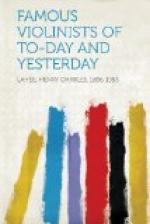“Vieuxtemps’s first concert on Monday night was a very stylish jam. He is a small, puny-built man, with gold rings in his ears, and a face of genteel ugliness, but touchingly lugubrious in its expression. With his violin at his shoulder, he has the air of a husband undergoing the nocturnal penance of walking the room with ’the child’—and performing it, too, with unaffected pity. He plays with the purest and coldest perfection of art, and is doubtless more learned on the violin than either of the rival performers [Ole Bull and Artot], but there is a vitreous clearness and precision in his notes that would make them more germane to the humour of before breakfast than to the warm abandon of vespertide. His sister travels with him (a pretty blonde, very unlike him), and accompanies him on the piano.”
Vieuxtemps also visited America in 1870, with the celebrated singer Christine Nilsson.
Among the celebrated violinists of this period must be mentioned Bernhard Molique, of whom Sir Charles Halle says that he was a good executant, knowing no difficulties, but his style was polished and cold, and he never carried his public with him. “Ernst,” he continues, “was all passion and fire, regulated by reverence for and clear understanding of the masterpieces he had to interpret. Sainton was extremely elegant and finished in his phrasing, but vastly inferior to the others. Vieuxtemps was an admirable violinist and a great musician, whose compositions deserve a much higher rank than it is the fashion to accord them.”
Molique was the son of a town musician of Nuremberg, and became a composer whose works have stood the test of time. He was a pupil of Kreutzer and of Spohr, and held the position of director and first violinist of the royal band at Stuttgart. He had a number of excellent pupils, of whom John T. Carrodus was the best known. He died at Stuttgart in 1869.
Henry Gamble Blagrove was a musical prodigy, who began the study of the violin at the age of four, and appeared in public a year later. He was born at Nottingham in 1811, and at six years of age played at Drury Lane. He studied abroad with Spohr, and appeared in Vienna in 1836, but the greater part of his life was spent in England, where he was soloist in several of the best orchestras. He was a man of refreshing modesty, and was held in high esteem. He died in London in 1872.
Jacob Dont, of Vienna, and Jean Dancla, a French violinist, both belong to this period, and were teachers of reputation.
CHAPTER VI.
OLE BULL.
“A typical Norseman, erect of bearing, with a commanding presence and mobile, kindly face, from which the eyes shone clear and fearless as the spirits of old Norway hovering over his native mountains. He was a man to evoke respect and love under all conditions, and, when he stepped before an audience, roused an instantaneous throb of sympathy, of interest, before the sweep of his magical bow enthralled their souls with its melodious measures.” Such is an excellent pen picture of Ole Bull, who during the middle of the nineteenth century was known far and wide as a great violinist.




